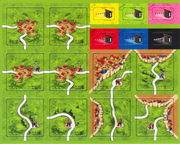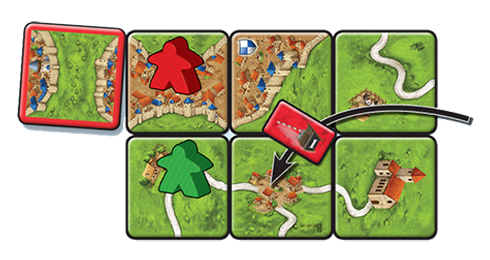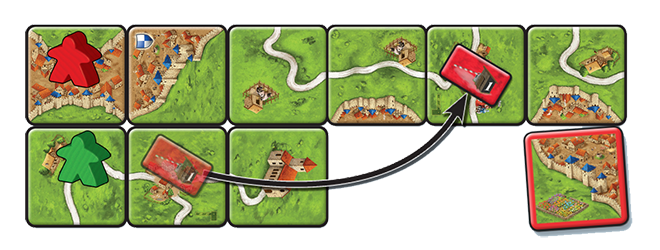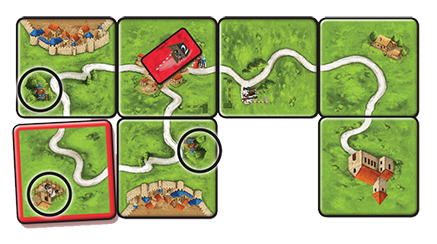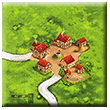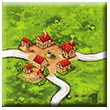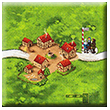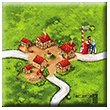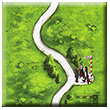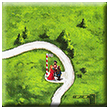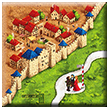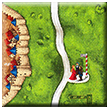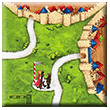Difference between revisions of "The Tollkeepers/nl"
(Created page with "Als je '''geen meeple zet''' mag je je '''tolhuis inzetten''' met de 1 (kleine tol) naar boven. Als je tolhuis al in het spel is, mag je die verplaatsen. De spelregels hiervoo...") |
(Created page with "* Je mag je tolhuis alleen op een '''kruising''' leggen. Een kruising is een dorp met 2-4 wegen eraan. Een stad of klooster met twee of meer wegen geldt niet als kruising.") |
||
| Line 50: | Line 50: | ||
Als je '''geen meeple zet''' mag je je '''tolhuis inzetten''' met de 1 (kleine tol) naar boven. Als je tolhuis al in het spel is, mag je die verplaatsen. De spelregels hiervoor zijn als volgt: | Als je '''geen meeple zet''' mag je je '''tolhuis inzetten''' met de 1 (kleine tol) naar boven. Als je tolhuis al in het spel is, mag je die verplaatsen. De spelregels hiervoor zijn als volgt: | ||
* | * Je mag je tolhuis alleen op een '''kruising''' leggen. Een kruising is een dorp met 2-4 wegen eraan. Een stad of klooster met twee of meer wegen geldt niet als kruising. | ||
[[File:Tollkeepers_C2_Feature_Crossroads.png|none|frame|'''Example:''' 3 land tiles with crossroads]] | [[File:Tollkeepers_C2_Feature_Crossroads.png|none|frame|'''Example:''' 3 land tiles with crossroads]] | ||
Revision as of 13:58, 5 July 2020
Algemene informatie en opmerkingen
File:Tollkeepers C2 Expansion Symbol.png Markering |
De Tolbeambten werd in oktober Template:Year nl uitgegeven door HiG.
Met deze mini-uitbreiding doen tolbeambten hun intreden in het spel. Ook in het verleden werd er al tol geheven over mensen en goederen. Er werd een "kleine tol" geheven (voor tranportwijze) of "grote tol" (voor goederen).
Deze uitbreiding is ontworpen voor het basisspel van Carcassonne. Alle standaard spelregels zijn van kracht, aangevuld met de spelregels voor deze uitbreiding. Je kunt deze uitbreiding – op eigen risico – ook met andere uitbreidingen combineren, er zijn namelijk geen officiële regels voor die combinaties.
Speelmateriaal
- 10 landtegels, waarvan 8 met een groep reizigers.
- 6 tegels met tolhuizen in de verschillende spelerskleuren.
Spelregels
Voorbereiding
Schud de 10 landtegels door de rest van de landtegels. Iedere speler krijgt de tolhuizen van zijn kleur.
1. Landtegel leggen
Het trekken en aanleggen van landtegels gebeurt volgens de gebruikelijke spelregels.
2. Een meeple zetten
Na het aanleggen van een landtegel mag je volgens de gebruikelijke spelregels een meeple zetten.
Als je geen meeple zet mag je je tolhuis inzetten met de 1 (kleine tol) naar boven. Als je tolhuis al in het spel is, mag je die verplaatsen. De spelregels hiervoor zijn als volgt:
- Je mag je tolhuis alleen op een kruising leggen. Een kruising is een dorp met 2-4 wegen eraan. Een stad of klooster met twee of meer wegen geldt niet als kruising.
- It makes no difference where the crossroad is. You don't have to place/relocate your tollhouse on the land tiles you've just placed.
- The crossroad has to be free, that is, there can't be another tollhouse. [1] It doesn't matter, however, if there is a meeple placed on the respective crossroad land tile.
- When relocating the tollhouse, the value (1 or 2) stays the same.
- Having placed your tollhouse, it stays in the game until the end. You'll never take it back to your supply.
3. Scoring a feature
If you or another player complete a road beginning or ending where your tollhouse is, you raise a toll, that is, you get points for this road.
- For the small toll (showing the 1), you get 1 point for each farmhouse [4], shed [5], garden or highwaymen, and 3 points for each group of travellers.
- For the large toll (showing the 2), you get 2 points for each farmhouse, shed, garden or highwaymen, and 6 points for each group of travellers.
If there isn't anything like that on the road, you don't get any points for your tollhouse.
Additionally, the owner of the completed road will score their points as usual.
![]() Vraag: What are farmhouses, sheds, gardens and highwaymen?
Vraag: What are farmhouses, sheds, gardens and highwaymen?
Toll changes with travellers
If you have scored at least one group of travellers with your tollhouse, you change its value. The small toll (1) becomes the large toll (2) or vice versa.
You change your toll only at the end of your turn. If you score more than one road with one toll within the same turn, its value is the same for all the roads.

Green gets 4 points for their road as usual.
Final scoring
At the end of the game, you get points for all incomplete roads connected to your tollhouse. You get 1 point for each farmhouse, shed, garden, highwaymen as well as for each group of travellers no matter which number your tollhouse shows.
Tile distribution
Total Tiles: 10
Total Tollhouse Tiles: 6
Footnotes
For Icons explanation and licensing please visit Icons page.
- ↑
 The rules don't take into consideration any tollhouses placed on other crossoads ending the road. This means a road ending at several crossroads allows players to place their tollhouses on any of available free crossroads even if any of the other crossroads was already occupied by other players' tollhouses.
The rules don't take into consideration any tollhouses placed on other crossoads ending the road. This means a road ending at several crossroads allows players to place their tollhouses on any of available free crossroads even if any of the other crossroads was already occupied by other players' tollhouses.
- ↑
 This scoring for tollhouses is especially designed for Carcassonne II. There is no official clarification about how tollhouses are scored for tiles with Carcassonne I artwork.
This scoring for tollhouses is especially designed for Carcassonne II. There is no official clarification about how tollhouses are scored for tiles with Carcassonne I artwork.
- ↑
 Tollhouses may be scored taking into consideration the little farmhouses present on road tiles.
Tollhouses may be scored taking into consideration the little farmhouses present on road tiles.
- ↑
 The term "farmhouse" is used instead of "farm", as in the original rules, in order to be consistent with the naming used in the base game and The Markets of Leipzig.
The term "farmhouse" is used instead of "farm", as in the original rules, in order to be consistent with the naming used in the base game and The Markets of Leipzig.
- ↑
 The term "shed" is used instead of "stable", as in the original rules, in order to be consistent with the naming used in The Markets of Leipzig.
The term "shed" is used instead of "stable", as in the original rules, in order to be consistent with the naming used in The Markets of Leipzig.
- Editor Manual - Old numbered parameters - RulesPlacingTile
- Editor Manual - Old numbered parameters - RulesPlacingMeeple
- Editor Manual - Old numbered parameters - Tile
- Editor Manual - Old numbered parameters - FAQ
- Editor Manual - Old numbered parameters - RulesScoring
- Second Edition
- Second Edition Minor Expansion
- Old template
- Old template - FootnoteIconPara en
